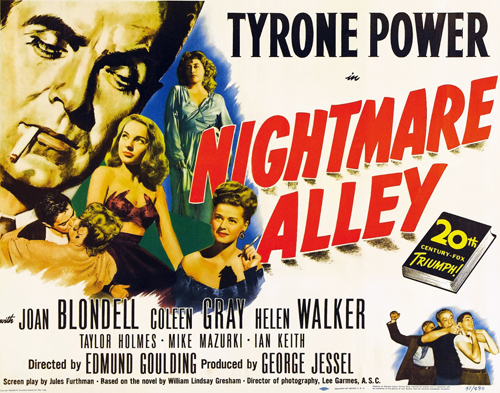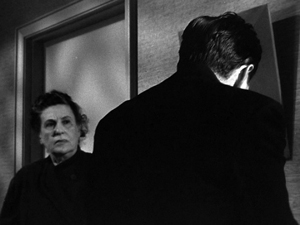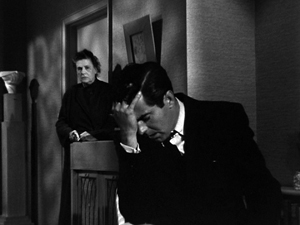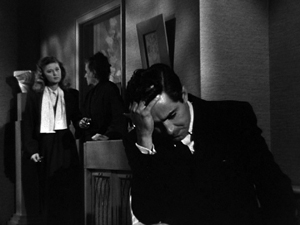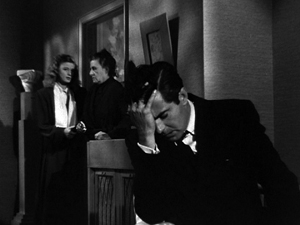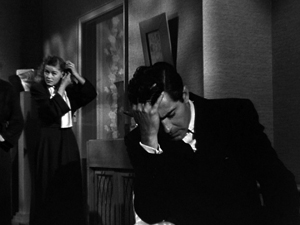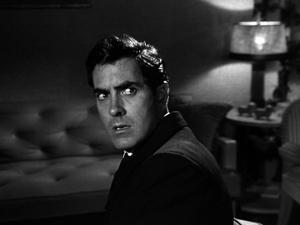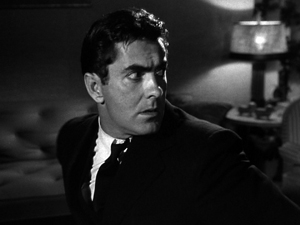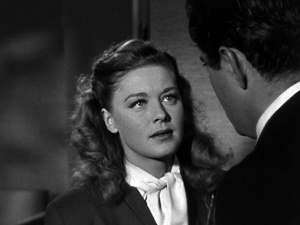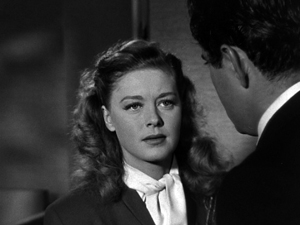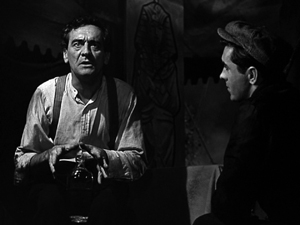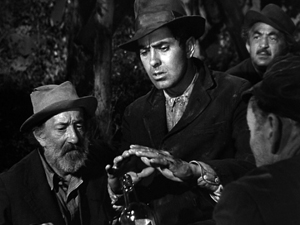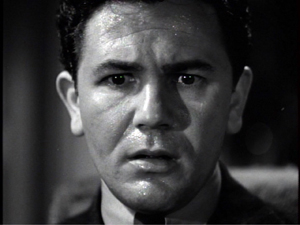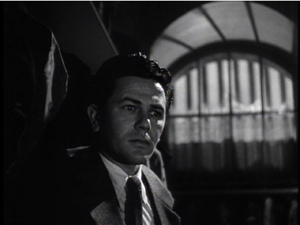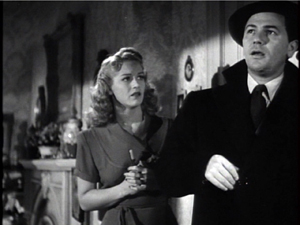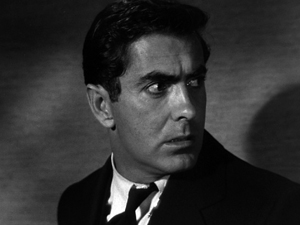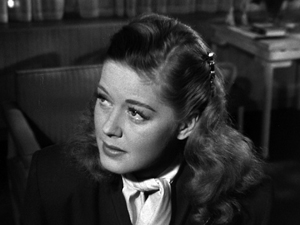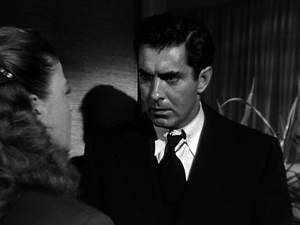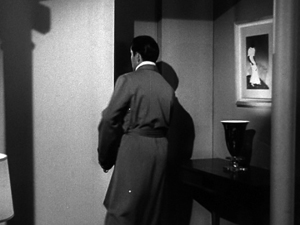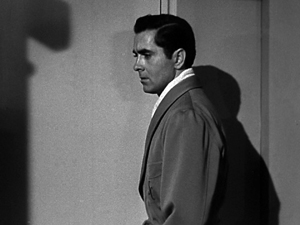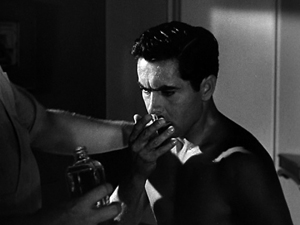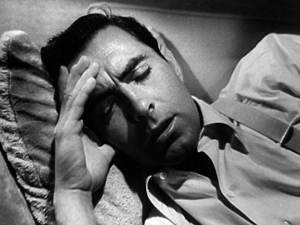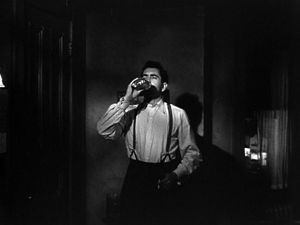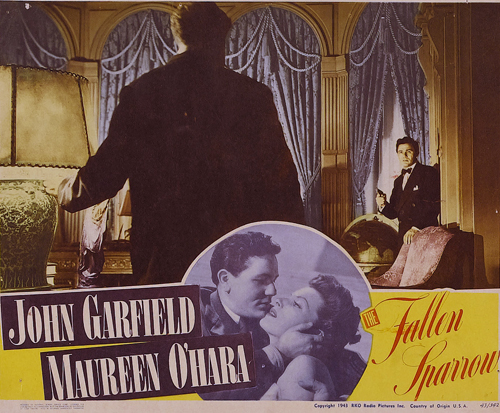NIGHTMARE ALLEY: Do we hear what he hears?
Wednesday | September 30, 2015 open printable version
open printable version
DB here:
In the 1940s, American cinema turned wildly subjective. Visions, daydreams, nightmares, optical and auditory POV, inner monologues, flashbacks, and stream-of-consciousness montages were popping up everywhere. Sometimes these techniques rendered what it felt like to be the character at that moment. At other times, they were occasions for gags, or padding, or spikes of emotion, or flamboyant spectacle.
Sometimes they were just weird.
Siren song
One of the most intriguing passages in Forties films comes at a climactic moment in Nightmare Alley (1947, the year I was born). Spoilers ahead.
Stan Carlisle has been involved in a complicated swindle with the help of psychologist Lilith Ritter. He has entrusted her with $150,000 in cash extracted from their mark. When the plan goes wrong, he reclaims the money and heads for the railroad station to meet his girlfriend Molly.
In the cab en route to the station, Stan discovers that the wad of cash Lilith has given him consists of 150 singles. He returns to her apartment to confront her. There Lilith suddenly goes coldly clinical, declaring that Stan is deluded. Just as he thinks he killed a man in Texas, and he has imagined that she’s involved in his swindle. She denies any collusion with him, but does hint that she could get him indicted for the killing.
Since he has been growing more anxious, her calm stream of lies unnerves him. And since she records all her sessions with her patients, she has his first visit as a confession to the Texas killing. She has been careful to never record their swindle plot.
As Stan gets more panicky, we hear a police siren. He reacts, but Lilith does not. She claims not to hear it; she says he’s just imagining it, like everything else. When she offers to take him to a hospital, he pulls away and flees, without his money.
Here’s the scene.
Is the siren objectively in the scene, or is it in Stan’s head?
Lilith says she doesn’t hear the siren, so it might be subjective, manifesting Stan’s guilty conscience. And all the psychologist’s talk about hallucinations may have induced one in him. But the siren isn’t distorted in the way most auditory imaginings are; it seems plausibly part of the story world. And many viewers (including me, on my first viewing) assume that Lilith or her servant Jane has called the police, and the cops are now arriving. Lilith could be pretending not to hear the siren in order to convince Stan he’s loco. She does tell him to stay for a sedative.
There are several oddities here besides the siren. For one thing, Jane has made her entrance keeping Stan covered with her pistol. When Stan and Jane leave the bedroom, we see Jane hovering in the background.
As Lilith comes out she cocks her head screen left, signaling to Jane, and swivels the pistol firmly toward Stan.
Once Stan and Lilith get into their argument, though, Jane is no longer seen or heard. She’s last glimpsed as a sleeve on its way offscreen.
We never see Jane definitely exit the room. Is she there or not? Did Lilith’s head gesture mean “Stand over there to keep him covered” or “Go off and call the police”? The film’s continuity script (typically a transcript of the editor’s version with dialogue and effects but without music) says only “Jane crosses and exits scene.” That could mean she leaves the room or merely leaves the frame.
Moreover, we learn from cinematographer Lee Garmes, who shot Nightmare Alley, that Goulding preferred clearly signaled entrances and exits.
He had no idea of camera; he concentrated on the actors. He had the camera follow the action all the time. He was the only director I’ve known whose actors never came in and out of the sideline of a frame. They either came in a door or down a flight of stairs or from behind a piece of furniture. He liked their entrances and exits to be photographed. I like that; they didn’t just disappear somewhere out of the frame-line as they so often do.
“Disappear somewhere out of the frame-line” is just what Jane does.
Jane’s presence or absence matters because of the quarrel that ensues. When Lilith announces her betrayal of Sam, we might expect the muscular Stan to attack her, slapping her around like the good noir sucker he is. But he meekly takes her assault. True, he’s coming apart, but maybe he’s holding back partly because Jane still has him covered from offscreen. That assumption seems validated at one point, when Stan’s nervous glance sharply off right suggests that she’s still there with her pistol. It’s after that glance that he warns Lilith not to call the cops.
Of course he could be imagining Jane in another room calling the police. On the other hand, if we assume that Jane remains offscreen, Lilith’s cool story about Stan’s breakdown becomes motivated as a performance in front of a witness who can back her up.
Maybe the handling of Jane is just clumsy direction on Goulding’s part? Or just conciseness? Still, there’s that siren. If Jane is in the room all the while, and we don’t hear her telephone the cops offscreen, the siren can’t be the result of a call for help. And it’s not clear that Lilith had the time to phone the police after Stan left the bedroom.
So maybe the siren is indeed in Stan’s head. Or if it’s objectively in the story world, then maybe it’s just a coincidence. (Chicago has plenty of sirens.) In this case, Lilith takes advantage of the siren to weaken Stan’s grip even more. A further complication: The siren cuts off as Stan flees, but there’s no indication that the cops have arrived outside. And in another oddity, we see Lilith turn slightly toward the camera when she denies hearing the sound. Is this a mark of evasion, like blinking?
In sum: The siren is either subjective or it’s objective. If it’s subjective, it’s at variance with most subjective sound of the period in not being signaled clearly as such. If it’s objective, it’s either the result of somebody calling the cops from offscreen, or it’s just coincidental.
Which is it? Usually a Forties film is pretty explicit when we’re in a character’s head, if only in retrospect (e.g., the staircase “death” in Possessed, 1947). Nightmare Alley seems to fudge things here.
When being a geek isn’t chic
Am I over-thinking this? The commentators on the Eureka! DVD, noir experts Alain Silver and James Ursini, puzzle over the siren too. I think that when Lilith denies hearing it, most viewers feel a bump: after all, we hear it too. But soon, I think, most of us take it as a real siren and assume that Lilith seizes on it as another way to convince Stan he’s breaking down. As for Jane, we just forget about her.
Look at the overall film, though, and the subjectivity possibility gains a curious strength. The siren can be taken as part of a peculiar pattern running through the film. To show you what I mean, I need to rehash a fairly complicated plot. Bear with me.
Stan Carlisle, an ambitious carnival worker, is conducting an affair with Zeena, the fortune-teller, while her partner Pete sinks into alcoholism. Stan accidentally kills Pete by giving him a bottle of wood alcohol instead of moonshine. Partnering with Zeena, Stan masters a code system for a mind-reading act. Soon he has left Zeena behind and married the carnival entertainer Molly, who becomes his confederate in a ritzier nightclub mentalist act. But Stan is plagued by memories of Pete’s death. He visits a psychologist, Lilith, to whom he tells his guilt feelings.
Stan conceives a grand scheme to turn faith healer, using his skills at illusion and fake spiritualism. (“The spook racket: I was made for it.”) He manages to deceive the rich Ezra Grindle, who asks to see his deceased lover. The scheme, in which Molly impersonates a spirit, fails and Stan has to flee, hoping to take with him the money he’s already wormed out of Grindle. Lilith blocks that in the scene I’ve excerpted.
Stan leaves Molly and begins to spiral downward into drunkenness. By the film’s end he’s ready to take on the job of the geek, the subhuman carnival freak who bites heads off chickens. Originally Stan had despised the geek, but now, in order to be guaranteed a bottle a day, he declares: “I was made for it.” Only Molly’s tender concern holds out hope Stan might claw his way back.
I said the plot was complicated, but it rests on a set of fairly simple substitutions. The opening situation gives us two couples, Zeena and Pete, Molly and the strong man Bruno. Initially Stan was odd man out, paralleled by the geek (also on the fringes of the action). Stan replaces Pete as first Zeena’s lover and then her stage partner. But once Stan knows the mentalist codes, he can replace Zeena with Molly, whom Bruno surrenders. Later Zeena and Bruno will form a couple. In Stan’s rise, Molly gets replaced by Lilith, his partner in crime, if not in romance. When Stan’s swindle fails, he goes on the run, alone again. Pete was established as one step up from geekdom; without Molly, he said, he’d be a geek. Now Stan becomes the new Pete. Drinking around a campfire with bums, he even repeats Pete’s cold-reading spiel word for word and gesture for gesture, with a bottle of booze as the crystal ball.
Stan finally sinks to the bottom, willing to serve as a carnival geek for the standard bottle a day. Molly now plays Zeena to the new Pete.
The pattern of sound leading up to the siren scene centers on the geek. In the crucial scene in which Stan gives Pete the rubbing alcohol, the geek’s cries punctuate the action as he dashes around in the distance; like Pete, he needs his daily bottle. But we hear those cries three more times later, when the action has left the carnival. The cries are displaced from their original source, and more insistent on each appearance.
The first time, they’re very faint. Zeena and Bruno have called on Stan and Molly in their nightclub dressing room. Zeena has brought out her Tarot deck and seeing Stan’s future she warns him not to try the big thing he’s contemplating. (It’s the fleecing of the grieving Grindle.) Worse, her cards bring up the Hanged Man, the same card that Zeena turned up for Pete. Once the association with Pete has returned, it’s hard to exorcise.
Angry, Stan forces Zeena and Bruno out, and as he stands at the door, with the music rising, we can hear the distant cries of the geek. In the next scene, the association with Pete is strengthened. Stan is getting a massage and the smell of the rubbing alcohol reminds him of the night of Pete’s death. Now, more strongly, we hear the geek.
The motif-cluster is Pete’s death/Hanged Man/rubbing alcohol/the geek. This is brought back again, most obviously, when on his downward path Stan is holed up in a hotel room and instead of eating starts to guzzle a bottle of gin.
The compulsive drinking, along with Stan’s disheveled life, marks another stage in his conversion into Pete, and the geek’s cries are heard most plaintively now.
So what do we make of the geek’s cries in these scenes? If we take them as subjective, as Stan’s auditory flashbacks or imaginings, then the siren moment gathers a new force. If we’ve had access to Stan’s mental soundscape earlier, maybe we have it again when he “hears” the police coming. After several instances of subjective sound, we’re more prepared to take the siren as subjective too—and to wonder a bit about it even after we’ve concluded that it’s probably objectively in the scene.
That feint would be an interesting storytelling maneuver in itself. Yet other factors complicate things.
The geek goes Greek
In 1940s movies, there’s plenty of subjective sound. Often we understand that a sound is subjective by virtue of its acoustic quality; it may be given extra reverb or distorted in other ways. We also take it as subjective because the sound clearly isn’t coming from the scene. We often remember it from prior scenes and so treat it as an auditory flashback. But there are visual cues for subjective sound too. The two primary ones are a close view of the character whose mind we’re in, and an expression on the character’s face that indicates some intense feeling.
In The Fallen Sparrow (1943), Kit recalls his months in a Spanish prison chiefly through the scraping limp of one of his captors passing in the hall. When we’re given access to that acoustic memory, we get fairly close shots of Kit’s agitation.
In an interesting parallel to Nightmare Alley, when Kit is with Whitney, he thinks he hears the scraping footbeat again.
It might be a genuine offscreen sound, since we have reason to believe that his torturer has followed him to New York. (In the climax, the sound will be actual, not imaginary.) But at this point Whitney says she doesn’t hear the noise, and neither do we. This indicates that Kit is imagining it. The filmmakers faced a problem comparable to that in the Nightmare Alley scene. If the sound had played for us as well as for Kit, and Whitney said she didn’t hear it, the options are three: we’re in Kit’s head, though she isn’t; it’s real and she truly didn’t hear it; or it’s real and she’s lying (as Lilith may be). We couldn’t be absolutely sure we were in Kit’s head if the sound had been included, but when it’s not on the track, we know he’s hallucinating.
There are several norms to consider here. First, typically the close shot is timed to coincide with the subjective sound, indicating that the character registers the sound when we do. That happens in The Fallen Sparrow, but not in Nightmare Alley. We notice the siren before Stan does, which suggests that it’s objective.
Second, the shot isolating the character favors our taking a sound as subjective. But when another character is in the shot, it’s harder to construe as subjective. Accordingly, in The Fallen Sparrow, the shot that includes both Kit and Whitney inclines the filmmakers to treat the shot as objective and the sound as purely private, as inaudible to us as it is to her. In Nightmare Alley, the siren does indeed start over a close-up of Stan, but it continues over a reverse-shot of Lilith and soon enough, over a shot of the two of them.
Finally, our sense of subjectivity depends partly on the intrinsic norm each movie sets up. In The Fallen Sparrow the scraping footstep takes its place in long stretches of inner monologue which vocalize Kit’s thoughts. Because we’ve had intimate access to his mind, we’re likely to accept the footstep we hear as subjective as well. But Nightmare Alley doesn’t include inner monologues. We never access Stan’s stream of thought, so the geek cries are the only moments we might be plunging into his mind–at least, until (perhaps) the siren scene.
The siren scene hangs uncertainly between subjectivity and objectivity, tilting toward objectivity but also casting some doubts on it. What about the geek sounds? They’re even more complicated. They seem to hang between subjectivity and–well, something else.
Take the first instance. Stan is at the doorway and the camera tracks in to him as the musical score emerges. The geek noises slip in, and Stan pauses, as if reflecting.
That seems like a fairly standard cue for subjectivity: Stan has associated the Tarot cards and Pete’s death with the geek’s cries. Because of the faintness of the noise (some people seem not to notice it, as if the score nearly drowns it out), the narration might even be hinting that Stan’s memory of the night of Pete’s death is barely conscious.
In the light of the later occurrences, I’d propose another possibility. Given that we’ve never been in Stan’s head before, the sound might be more addressed to us than to him, reminding us of an association he doesn’t sense at all. This moment might almost be the film’s way of taking us aside and flagging a motif that will develop later–and in ambiguous ways.
In the rubdown scene, we see Stan, anxiously reacting to the smell of alcohol, in a fairly close view as the geek’s cries are heard.
In great anxiety, he leaps off the rubbing table. But perhaps he’s reacting just to the smell of alcohol, not to his memory of the geek. Again, the geek sounds are smoothly merged with a burst in the musical score.
Most characters who hear imaginary sounds report them to the people around them. But Stan hasn’t said anything, as far as we know, to Molly about twice hearing the geek. When Stan tells Lilith of the two earlier scenes during his therapy session, he mentions only being disturbed by Zeena and the cards, and the way the alcohol reminded him of Pete.
He doesn’t mention hearing the geek’s cries. So again we might ask if these cries aren’t subjective but rather something like a nondiegetic score–the soundtrack reminding us of something Stan isn’t remembering.
The last recall of the geek’s cries is presented while Stan is gulping gin. The noise starts in a medium shot before the camera retreats to a distant view.
If the cries make him feel tormented, he doesn’t give much sign of it. And if we were supposed to penetrate his mind, where the geek noises might reside, the camera would typically track in more tightly (as it does in The Fallen Sparrow). Instead, it withdraws, again raising the possibility that the geek’s shrieks are a commentary, not a recollection. Perhaps the cries are more like the Greek chorus warning us of an outcome to which the protagonist is oblivious.
What are we left with? Mixed signals, I think. The geek’s cries and the police siren hover in a space that many films worked within but seldom treated so freely. The cries can be taken as subjective, but they lack robust cues for that function. In other respects, they suggest expressive commentary. As the alcohol reminds Stan of Pete’s death, the cries do the same for us, while prophesying Stan’s fate. And the siren, while probably objective, makes us hesitate partly because we’re not sure the police have been called and partly because we’ve had ambivalent sound cues earlier. For a moment it might seem to be, as Lilith says, Stan’s first full-blown hallucination.
The continuity script for Nightmare Alley duly notes the siren’s sound, and the geek’s cries are noted in the scene of Pete’s death. But there’s no mention of geek cries in any of the three scenes I’ve considered. Perhaps director Edmund Goulding shot the film without planning to include the geek sounds at all. Perhaps they were added in postproduction. Someone late in the production process may have decided to anticipate Stan’s final degradation through ever more vivid echoes of the poisoning scene. Nightmare Alley would become an example of innovation by last-minute intervention.
Usually a 1940s film respects the distinctions, the either/or options, that are offered by the era’s stylistic menu. Accordingly, a sound is clearly objective or clearly subjective. But sometimes a film oscillates between the choices, or blurs the distinctions among them. We’re most familiar with this slipperiness when music shifts between being diegetic (sourced in the story space) and being nondiegetic (added to the story world “from outside”). This sort of looseness can be found elsewhere in 1940s storytelling. A film may start with one narrator and end with another, or none, or an uncertainly identified one. A flashback may never close, or loop back to its beginning without returning to the frame story. The outliers coax us to study how the ordinary cases work and note how much we take their conventions for granted.
We can learn as much about storytelling strategies from the ambivalent films as from the trim and polished ones. And in a movie called Nightmare Alley, we can’t regret that the haunting wail of the geek wafts through it as both a reminder of death and an anticipation of destiny. Its shape-shifting sound fits a movie that wants to unsettle us.
Fussbudget film analysis: I was made for it.
The continuity script for Nightmare Alley is available as a pdf file on the Eureka! DVD of the film.
Lee Garmes’ remark about explicit entrances and exits is quoted in Charles Higham, Hollywood Cameramen (Thames & Hudson, 70), 49-50. For background on the making of the film see Matthew Kennedy, Edmund Goulding’s Dark Victory: Hollywood’s Genius Bad Boy (University of Wisconsin Press, 2004), 241-252. There’s a detailed and intriguing psychoanalytic interpretation of the film at Randomaniac.
Actually, the scene in The Fallen Sparrow is a little more complicated than I indicate here, but I didn’t want to get into the weeds. The essential point holds, though: when one character thinks that a sound is veridical, and another character is present but doesn’t hear it, the filmic narration can confirm or disconfirm or ambiguate the source of the sound.
Thanks to conversations with Kristin, Jeff Smith, and Jim Healy about the film. Woody Haut’s lengthy discussion of the film for the Eureka! disc is reprinted on his website.
I discuss extrinsic and intrinsic norms of narration in Chapters 4 and 8 of Narration in the Fiction Film.
For other example of fruitful anomalies in the period, see “Innovation by accident,” “Twice-Told Tales: Mildred Pierce,” and the Laura discussion in “Dead Man Talking.”












